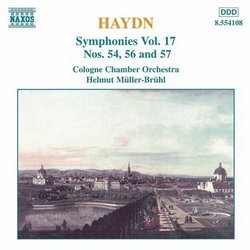| All Artists: Franz Joseph Haydn, Helmut Müller-Brühl, Cologne Chamber Orchestra Title: Haydn: Symphonies Nos. 54, 56 & 57 Members Wishing: 0 Total Copies: 0 Label: Naxos Release Date: 8/5/1997 Genre: Classical Styles: Historical Periods, Classical (c.1770-1830), Symphonies Number of Discs: 1 SwapaCD Credits: 1 UPC: 636943410820 |
Search - Franz Joseph Haydn, Helmut Müller-Brühl, Cologne Chamber Orchestra :: Haydn: Symphonies Nos. 54, 56 & 57
 | Franz Joseph Haydn, Helmut Müller-Brühl, Cologne Chamber Orchestra Haydn: Symphonies Nos. 54, 56 & 57 Genre: Classical
|
Larger Image |
CD Details |
CD ReviewsExploring the Haydn Symphonies -- Nos. 54, 56, and 57 Robin Friedman | Washington, D.C. United States | 10/15/2004 (4 out of 5 stars) "Haydn composed his symphonies 54,56, and 57 in 1774. These symphonies are lively, cheerful and graceful. Thus, they differ markedly from the minor-key symphonies, such as the "Lamentation" "Trauer" "La Passione" and others that Haydn composed in the late 1760s. These symphonies are lyrical and make good use of the interplay between strings and winds and of contrasts in dynamics. In addition, each of these works has a lovely slow movement.
Symphony no. 54 in G major opens with a short slow introduction consisting of loud, stern passages contrasting with lyrical and quieter responses. This contrast sets the pattern for the entire work. Thus, the following "presto" opens with a march-like theme in the strings and horn followed by a softer, answering theme in the winds. The second movement, adagio molto, is substantially longer than the opening movement. It opens with a lengthy theme for the muted lower strings. As it progresses, the movement assumes a serious cast in an eloquent passage for the entire ensemble followed by a return of the opening material with solos added for violin. The minuet is a flowing melody for strings with the winds chiming in. The trio consists of a solo for the bassoon in the higher reaches of its register. The finale, marked "presto", is in sonata form and alternates a lively and joyous with a quiet theme for strings. The timpani has a preeminent role in this movement adding rhythm and joy. The symphony no. 56 in C major is the only one of this set without a slow introduction. The opening movement, "allegro di molto" features again a great deal of timpani together with contrasting themes in the strings. The movement comes to a big close which includes a trumpet fanfare. The highlight of the slow movement, "adagio", is a theme for the solo bassoon which appears immediately after a short introduction for muted strings and continues throughout the movement. Haydn makes great use of this beautiful instrument. The minuet is moderately paced and stately in character with, again, marked use of tympani. The contrasting trio is a light theme predominantly in the winds. The finale, "prestissimo" is in sonata form and begins with a growling figure for the lower strings answered by the higher strings. This movement makes much use of triplet figures and the timpani again sets the rhythm. The third symphony on this CD,no. 57 in D major, opens with a slow introduction that is longer and more tentative in character than the introduction for symphony 54. The introduction is followed by a galant allegro with a dashing opening theme and a more lyrical second theme. The lovely adagio, opens with a passage for plucked strings followed by the passage repeated in bowed strings. As the movement progresses, this pattern is repeated and embellished. The bowed melody becomes more embellished and the winds ultimately join in. The movement ends quietly with the plucked passage with which it began. The minuet is quiet and bouncy with an oom-pah-pah accompaniment; but the contrasting trio moves into the minor. The finale, "prestissimo" is in perpetual motion with sections that slow down briefly and with a brushy theme that appears at time under held notes in the winds. There is a brief dip into the minor key, but the movement offers a happy and humorous conclusion to a delightful work. This CD is part of a compilation of the Haydn symphonies on the budget-priced Naxos label. The performers are the Cologne Chamber Orchestra under the direction of Helmut Muller-Bruhl. The symphonies on this disk are not among Haydn's better-known works. But they contain much to enjoy by those listeners eager to explore the works of this great and still under-appreciated master. " |

 Track Listings (12) - Disc #1
Track Listings (12) - Disc #1